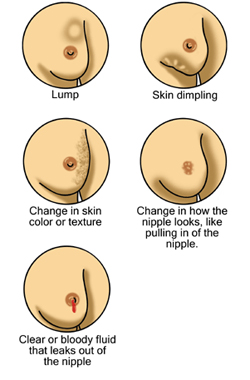BSE is a visual and physical examination for any changes in the breasts and underarms which you or a trusted person can perform on you.
Age 20 – 39
Do Breast Self-Examination (BSE) once a month, between the 7-10 day from the start of your period
Do Clinical Breast Examination (CBE) once every 3 years, though some recommend that you do it once a year upon reaching 30 years old.
Age 40 and above
Do monthly BSE. For women who have reached menopause, do it on a specific date of the month.
Do CBE and mammogram once a year

Being breast aware means knowing how your breasts usually look and feel. Look for changes in the:
Breast size and shape, pain and lump
- An increase in size of one breast.
- One breast has suddenly shifted position/height.
- Unusual thickening of the breast skin.
- A painless lump in the breast or armpit.
- Unexplained pain in the breast with no lump.
Skin
- Swelling, redness or distortion of the breast skin.
- Puckering or dimpling in the skin of the nipples or breast (skin texture similar to an orange peel)
- A sore or ulcer on the breast skin that does not heal.
Nipple
- Sticky or bloody nipple discharge.
- Scaling, crusting or erosion of the nipple.
- Inversion or retraction of the nipple or area surrounding the nipple (areola)
Performing regular BSE is one way to increase your familiarity with your breasts. The key to BSE is to spot changes in your breasts. Look for changes that persist after your menstrual cycle or any changes that concern you.

Standing Up
Stand undressed in front of a mirror. Look at your breasts and check each breast for anything unusual, such as puckering, dimpling, scales or changes in size, shape or symmetry. Remember to look beneath each breast, using your hands to lift the breasts if necessary.
Look
Look for breast changes at three positions:
- Visually inspect your breasts, arms at the side, while facing forward and while turning from side to side.
- Then, clasp your hands behind your head and press them forward. You should feel your chest muscles tightening, allowing you to see the contours of your breasts. Turn from side to side so you can see the outer surfaces.
- Next, inspect your breasts while pressing your hands firmly on your hips and bending forward slightly, pulling your shoulders and elbows forward as well.
Feel
Standing erect again, raise one arm, and use the pads of the three middle fingers of the opposite hand to feel the breast. You can use lotion or powder to help your fingers glide easily over the skin, or you can do the raised-arm part of the exam in the shower with soapy skin.
Lying Down
Lie down with a pillow under your left shoulder, and put your left hand behind your head.
Feel
Feel your left breast with the pads of the three middle fingers of your right hand. Start at the outer edge and work inward toward the nipple. Then squeeze your nipple gently to look for discharge. Do the same thing to your right breast with a pillow under your right shoulder. Be sure to include the area up to your collarbone and out to your armpit.
Feel the tissue by pressing your fingers in small, overlapping areas about the size of a 10sen coin. To be sure you cover your whole breast, take your time and follow a definite search pattern – wedge, circle or lines, to help you perform BSE more thoroughly. You will be treated by a team of professionals, including some or all of the following:
- General Practitioners (GP) – The one who usually arranges your first referral to a specialist breast clinic.
- Oncologist – A doctor who specializes in the diagnosis, treatment and rehabilitation of cancer patients. A clinical oncologist is trained in giving radiotherapy and chemotherapy, while a medical oncologist administers chemotherapy only.
- Radiologist – A medically qualified doctor who specializes in the use of imaging techniques (X-rays, ultrasound, CT etc) for diagnosis, and the one who will interpret your mammogram.
- Pathologist – A doctor specializing in identifying diseases by studying cells and tissues under a microscope.
- Radiographer – A non-medically qualified person who assists the radiologist in imaging and is trained in using X-ray machines. Some also give radiotherapy.
- Breast Surgeon – A specialist in breast surgery who also does fine needle aspiration and biopsy. Some may also do reconstructive surgery.
- Breast-care nurse – Nurse with special training in dealing with breast disease, who offers information, support and advice.
- Ward nurses – A nurse who plans your care on the ward.
- Physiotherapist – Gives you exercises to do after surgery for you to regain your strength and fitness.
- Psychologist – Professional counselling that can help you cope with your illness, and deal with decisions about treatment, depression, anxiety as well as family issues.
- Social worker – Can help you work out practical difficulties including transport, childcare and financial issues
Related: Watch BSE Video.
